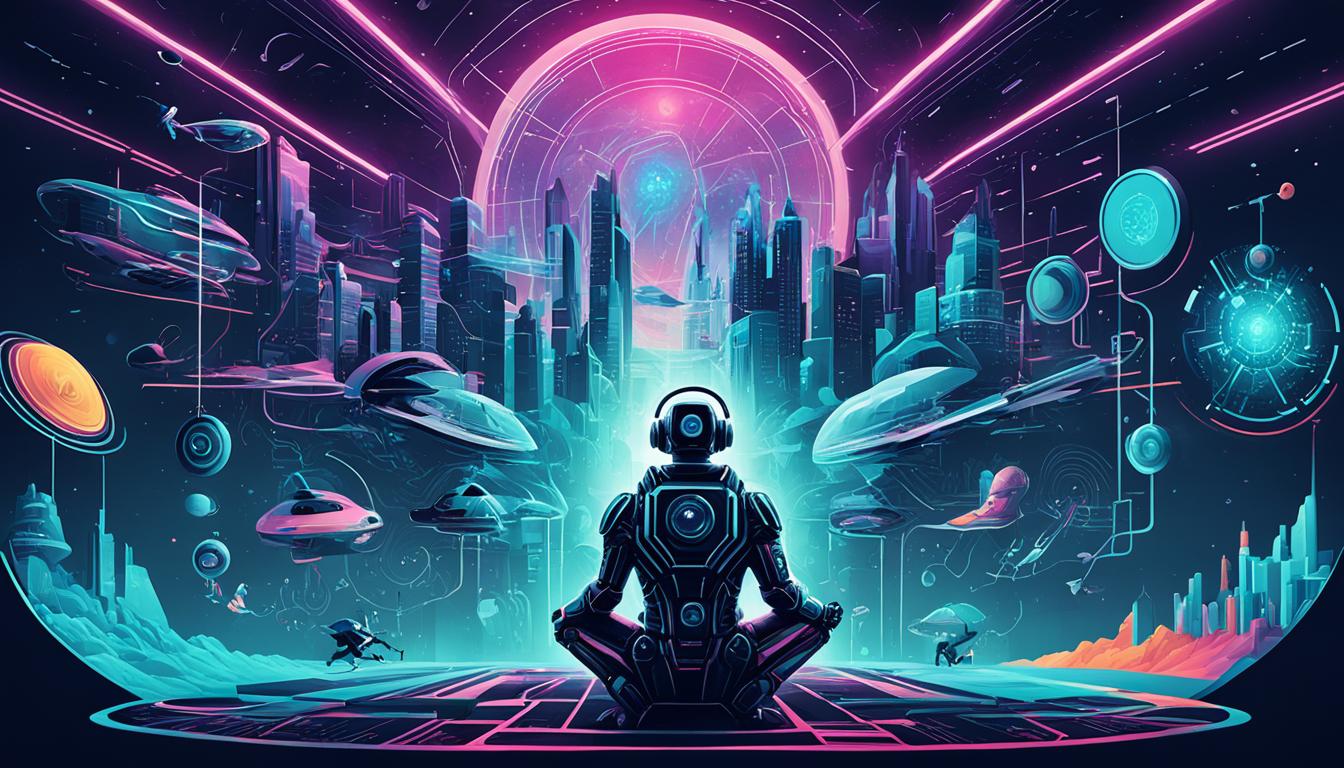“As an Amazon Associate I earn from qualifying purchases.” .
Storytelling has always linked us, passing on wisdom, sparking dreams, and connecting hearts. Now, storytelling is changing with artificial intelligence. AI brings new possibilities to storytelling, making stories in ways we’ve never seen before. It brings fresh creativity and new ways to engage with stories in our digital world.
The rise of AI in storytelling is more than just a tech step up; it’s a big change in how stories are made. AI blends with traditional storytelling to create stories that truly grab and move people. This mix of tech and creativity makes stories in new ways, reaching people everywhere.
Key Takeaways
- AI storytelling is changing the creative industry by integrating technology with traditional narrative creation.
- AI narrative generation tools enable the creation of vast and varied stories, pushing the boundaries of imagination.
- The rise of AI-driven platforms fosters a new ecosystem of storytelling that is both innovative and inclusive.
- Utilization of AI in storytelling helps overcome creative limitations and broadens the scope for creative narratives.
- This technological innovation holds the potential to significantly influence the future storytelling landscape.
Exploring the Evolution of Narrative Creation
The story of how we create narratives is both old and new. It blends traditional storytelling with fresh narrative techniques. Stories have moved from oral traditions by the fire to the high-tech platforms of today. This change shows how cultures and technology grow together.
Adding artificial intelligence (AI) to storytelling has been a game-changer. It changes how we think up, make, and enjoy stories. The impact of AI is not just about tech. It also makes us rethink what it means to create.
With AI, more people can tell their stories. AI improves on the old ways of telling stories. It lets us make complex plots and deep characters quickly and easily. Now, our storytelling is not limited by what a person can do alone.
Let’s look at key moments in how stories have changed, and AI’s role in them:
- Oral Traditions: Started with spoken stories, without writing but full of group involvement.
- Written Literature: Moved to writing, making stories last forever.
- Digital Storytelling: Uses new tech to make stories you can interact with.
- AI-Integrated Narratives: Uses smart algorithms for stories that change for each reader.
AI in storytelling is just starting. It shows a future where humans and AI work together. This partnership will change traditional storytelling and narrative techniques. It promises new ways to tell and experience stories.
| Aspect of Narrative Creation | Traditional Approach | AI-Enhanced Approach |
|---|---|---|
| Scope of Creativity | Limited by human imagination | Boosted by AI’s ability to analyze lots of data |
| Accessibility | Mostly for pro writers | Open to anyone with AI tools |
| Production Speed | Slow, depends on the person | Much faster, makes quick work of ideas |
| Personalization | Generic, one story for all | Unique, changes with the reader’s reactions |
AI is changing storytelling for the better. It’s making it quicker and open to more people. It also makes stories richer and more engaging. Looking ahead, the mix of AI and old ways of telling stories will spark new creativity. It continues the journey of storytelling.
Excavating the Depths of AI and Human Collaboration
The combination of AI and human creativity is more than just advanced tech. It’s a new way to tell stories with emotional storytelling. Together, AI and humans create stories that touch our hearts. They mix AI’s analytic skills with our own experiences and emotions.
AI helps us by processing and generating language quickly. This helps humans be more creative. Together, they make stories that are rich and complex. These stories couldn’t be made by humans or machines alone.

There’s a lot of talk about the ethics of AI, like in this discussion. It’s about what could happen if we mix AI and human creativity. But the main point is how to enhance emotional storytelling with AI without ignoring what’s right.
In this new era, AI helps writers by giving feedback. This makes the stories more touching and real. Because of this help, stories can make us feel more connected and understood.
To sum up, AI-human collaboration and AI language models have opened new doors. They have created stories filled with emotion that use both AI’s power and the human touch. The future looks bright, with even more ways for AI to help in storytelling. This promises great things for both creators and their audiences.
The Impact of AI on Traditional Storytelling Dynamics
AI is changing how we tell stories, making big waves in traditional storytelling. Storytellers can now use artificial intelligence to create AI-generated narratives. These stories change and adapt, offering a fresh challenge to old methods.
The shift caused by AI in traditional storytelling is deep and complex. It changes how stories are built and how storytellers and audiences connect. Unlike the old tales, AI stories are flexible and evolve.
AI stands out in making detailed story arcs that change based on what the audience wants. This is possible due to AI’s skill in recognizing patterns, a skill explained by tools like GPT-4. Linking to an article on this offers more insights. This gives birth to a new art form, engaging audiences deeply and creating a custom storytelling experience.
| Feature | Traditional Storytelling | AI-Generated Narratives |
|---|---|---|
| Adaptability | Low | High |
| Engagement | Static | Dynamic |
| Personalization | General | Highly Personalized |
| Creation Speed | Slower | Rapid |
| Emotional Depth | Deep | Variable |
Even with new tech, keeping the quality high in AI-generated narratives is tough. AI still struggles to match the emotional depth that humans can create. To fix this, there’s ongoing work to make AI understand and mimic human emotions better.
The debate between traditional and AI-generated stories will grow as AI keeps advancing. The future of storytelling will involve ethical issues and the need for rules. This will shape how AI storytelling evolves.
Blending AI with traditional storytelling could make stories more vibrant. It points to a future where stories are not just told. They are experienced in new and immersive ways.
AI Story: A New Chapter in Digital Narratives
The way we tell stories has changed with AI. This new era brings AI-generated stories and fresh ways to tell them. AI helps writers create tales that traditional methods couldn’t touch.

AI gives writers new powers in storytelling. AI plot generation tools create complex stories with surprises. AI character development makes characters with deep histories and real growth.
AI worldbuilding lets writers design detailed settings. These settings make stories feel real and full of life. From old-time cities to futuristic worlds, AI sketches environments that pull readers in.
| Feature | Impact on Storytelling | Examples |
|---|---|---|
| AI Plot Generation | Creates complex, multifaceted plots with twist endings | Meshing seemingly unrelated story arcs into a cohesive plot |
| AI Character Development | Develops dynamic characters with evolving traits | Characters adapting real-time to plot changes |
| AI Worldbuilding | Constructs rich, detailed settings for narratives | Seamlessly integrating fantasy elements into real-world settings |
Combining AI with storytelling opens new creative paths. It challenges old ways and takes stories to new places. As stories grow with AI, they connect deeper with readers. These stories become more lively, flexible, and engaging.
Conclusion: Envisioning the Future of AI-Crafted Narratives

AI’s integration into creativity marks a major shift in storytelling. The future of AI storytelling changes how we make and enjoy stories. It opens doors to new ways of expressing stories and AI creativity.
Advances in generative AI models play a big role in this change. These models can process huge data sets. They mimic human storytelling subtleties, making AI tales complex and true to life.
AI boosts AI in creative industries by supporting humans in storytelling. This partnership creates diverse story possibilities. Both humans and AI share in creating stories, blending their strengths.
AI also makes stories more personal and interactive. Users can change the story by their choices. This makes stories more engaging and deepens the emotional bond with the narrative.
Looking ahead, AI’s role in storytelling knows no limits. It promises to revolutionize how stories are told and experienced. For deeper insights on AI’s impact on storytelling, check out this analysis on Generative AI and Storytelling.
Resources and Further Reading
We are ending our journey through AI storytelling. We want to give our readers great resources and reading material. This will help them dive deeper into this exciting area. For those interested, there are many academic articles and research papers available. These will broaden your knowledge of how AI crafts stories and the techniques used.
For a deeper understanding, consider “Life 3.0: Being Human in the Age of Artificial Intelligence” by Max Tegmark. It explores how AI affects human life and storytelling. Another key book, “Artificial Intelligence: A Modern Approach” by Stuart J. Russell and Peter Norvig, is essential for learning about AI’s storytelling abilities. Both books are highly rated on Goodreads. They are valued by both beginners and experts in the field.
We urge our readers to keep looking for new information on AI storytelling. The field is always changing because of new technology. Staying up-to-date will not just improve your knowledge but also inspire you to use AI in storytelling in new ways. This journey is exciting for writers, educators, or anyone enthusiastic about the future of narratives.
FAQ
What is AI storytelling?
How has narrative creation evolved over time?
What is the relationship between AI and humans in the creative process?
How has AI storytelling transformed traditional storytelling techniques?
What are the transformative effects of AI on character and worldbuilding?
What does the future hold for AI storytelling?
Where can I find resources and further reading on AI storytelling?
Source Links
- https://www.storly.ai/power-of-ai-storytelling
- https://www.brandswan.design/the-rise-of-ai-storytelling/
- https://medium.com/@stelarius/artificial-intelligence-creativity-accelerator-and-revolution-in-narrative-creation-90569748394c
- https://medmattersmemo.com.in/the-future-of-ai-generated-storytelling-automated-narrative-creation-and-interactive-fiction/
- https://analyticsvidhya.com/blog/2023/10/ai-generated-poetry-and-literature/
- https://medium.com/coinmonks/ai-are-we-really-all-going-to-die-it-depends-21f3f1952df8
- https://www.linkedin.com/pulse/ai-future-storytelling-how-machine-learning-narrative-daniel-bron
- https://www.cmswire.com/the-wire/introducing-typeface-arc-the-next-chapter-in-storytelling-for-the-ai-era/
- https://medium.com/@olivermertens22/the-future-of-storytelling-how-a-i-is-transforming-narrative-techniques-ce2cebdfe975
- https://www.analyticsvidhya.com/blog/2023/09/how-generative-ai-transforms-the-craft-of-narration/
- https://emeritus.org/blog/best-books-on-ai/
- https://medium.com/nerd-for-tech/ai-in-the-classroom-4-must-read-books-e42136721e11
“As an Amazon Associate I earn from qualifying purchases.” .



